电磁炉电磁灶成品检验标准
- 格式:doc
- 大小:146.50 KB
- 文档页数:7
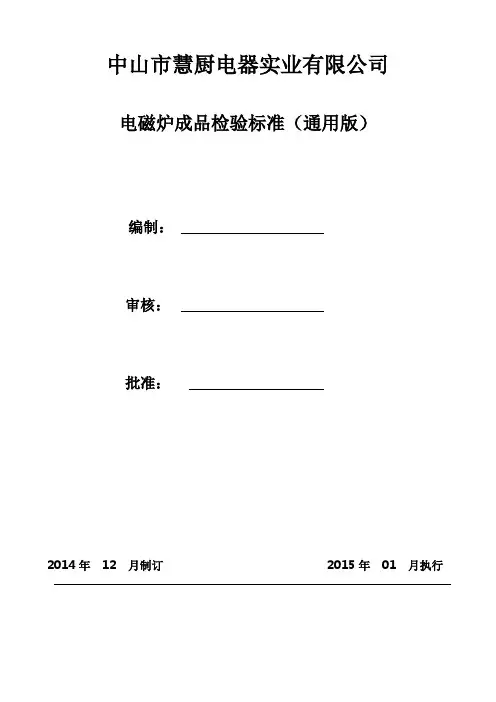
中山市慧厨电器实业有限公司
电磁炉成品检验标准(通用版)
编制:
审核:
批准:
2014年12 月制订 2015年 01 月执行
附抽样标准
1、OEM成品按照GB2828-2003正常水平Ⅱ的规定进行抽样。
a、其中A类质量特性的抽检数与B类质量特性的抽检数相同;
b、当B类与C类质量特性的抽检数不同时,应在相应的验货报告中“内分别注明抽检数。
2、合格判定:
a、A类不合格判定数为0/1(即出现一个A类不合格则判定整批为不合格)。
b、B类及C类质量特性的AQL值为:B=1.0;C=4.0。
c、特殊检验项目(特殊检验项目包括老化试验、干烧保护、非正常工作以及煮粥、煮饭、炒菜、
烧水、煎炸、、温奶、等功能检测项目):不进行加抽,其不合格判定数为0/1。
备注:特别注明抽检数的可按特别数抽检,其它按标准抽检。
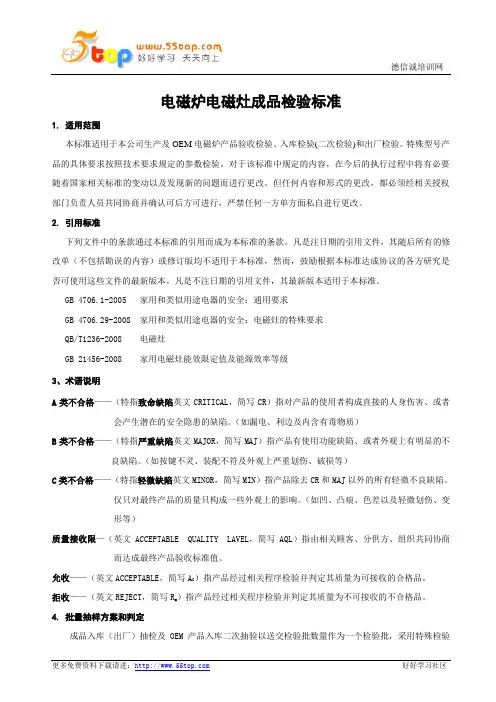
电磁炉电磁灶成品检验标准1. 适用范围本标准适用于本公司生产及OEM电磁炉产品验收检验、入库检验(二次检验)和出厂检验。
特殊型号产品的具体要求按照技术要求规定的参数检验。
对于该标准中规定的内容,在今后的执行过程中将有必要随着国家相关标准的变动以及发现新的问题而进行更改。
但任何内容和形式的更改,都必须经相关授权部门负责人员共同协商并确认可后方可进行,严禁任何一方单方面私自进行更改。
2. 引用标准下列文件中的条款通过本标准的引用而成为本标准的条款。
凡是注日期的引用文件,其随后所有的修改单(不包括勘误的内容)或修订版均不适用于本标准,然而,鼓励根据本标准达成协议的各方研究是否可使用这些文件的最新版本。
凡是不注日期的引用文件,其最新版本适用于本标准。
GB 4706.1-2005 家用和类似用途电器的安全:通用要求GB 4706.29-2008 家用和类似用途电器的安全:电磁灶的特殊要求QB/T1236-2008 电磁灶GB 21456-2008 家用电磁灶能效限定值及能源效率等级3、术语说明A类不合格——(特指致命缺陷英文CRITICAL,简写CR)指对产品的使用者构成直接的人身伤害、或者会产生潜在的安全隐患的缺陷。
(如漏电、利边及内含有毒物质)B类不合格——(特指严重缺陷英文MAJOR,简写MAJ)指产品有使用功能缺陷、或者外观上有明显的不良缺陷。
(如按键不灵、装配不符及外观上严重划伤、破损等)C类不合格——(特指轻微缺陷英文MINOR,简写MIN)指产品除去CR和MAJ以外的所有轻微不良缺陷。
仅只对最终产品的质量只构成一些外观上的影响。
(如凹、凸痕、色差以及轻微划伤、变形等)质量接收限—(英文ACCEPTABLE QUALITY LAVEL,简写AQL)指由相关顾客、分供方、组织共同协商而达成最终产品验收标准值。
允收——(英文ACCEPTABLE,简写A C)指产品经过相关程序检验并判定其质量为可接收的合格品。

0. ScopeThis document covers the specific quality requirements and defect classification for the above model.1. General informationIf a defect is located which is not specified herein, the Technical Manager, or in his absence the Quality Assurance Manager, of Markpeak Limited shall determine in which defect classification it is to be placed.The inspection procedure and defect classification is an endeavour to assureproduct quality and will be reviewed as necessary.2. Sampling planThe sampling plan to be used is MIL-STD-105E single sampling plan fornormal inspection using the following AQL’s for acceptance / rejection criteria:A. Critical defect 0.00%B. Major defect 0.65%C. Minor defect 1.50%3. Definition of defects and faultsDefects and faults are classified in 3 categories:Critical:i) Defect which could endanger a person’s safety whilst operating or maintainingthe product.ii) A defect which contravenes basic safety requirements as below:a) Low Voltage Electrical Equipment (Safety) Regulation .b) EMC/EMF CertificationMajor:A defect that interferes with the proper operation of the product and prevents itfrom fulfilling its function. Any missing components, accessories and packaging items. Any appearance defects which would prevent sale to any customers.Minor:A defect that does not substantially affect function of the product but results in theproduct not meeting set standards and requirements. Some minor appearance defects which should not result in outright rejection by customer at point-of-sale.Note:If a defect is not previously determined and classified, the above definitions are generally referred to for classification.Prior to the first shipment of any product, the supplier must provide documentation to the inspectors showing up to date certification to current standards from a Test House accredited by CNCA in the China or similar European or international bodies less such as the EA, ILAC or IAF.Marking DataModel No WKICHE211Colour Scheme : Unit –BlackBranding –Print on the plateRating information –printed on the rating labelLight --- Red Audit of1. PackagingA. M aster Carton1. Condition – undamagedMinor2. Printing correct.Minor3. CleanMinor4. Date coded. (YYWW format)Minor5. ITF barcode scanable – (See PO in details)Major6. Quantity per master = 2MajorB. Individual Carton1. Condition – undamagedMinor2. Printing correct.Minor3. Proper packaging with insertsMajor4. EAN Barcode scanable – (See PO in details)Major5. Ease of removal from cartonMinor6. Correct closure of cartonMinorC. Check contents to include.1. Instruction bookMajor2. Guarantee cardMajorNote: a. All plastic bags must have hole and suffocating warning printed. CriticalD. Units must pass packaging test standardsMajor(reference ISTA Test Procedure 2A). Test to be repeatedevery 3 months or, in the case of materials, packaging orcomponent changes, test to be performed at time of change(s).2. ProductA. Date Code, Product Identification, Rating InformationCriticalAnd Cautionary Information IncludedB. 1. Appliance and all accessories to be clean, free of burrsMajor/Minorproper colour and be capable of assembly as per instructions2. All parts must fit and be securedMajor/MinorC.Appliance Main Body (Critical components see appendix.)Black Crystal plate on top with touch panel.in 3 languages warning and settings.Major1. Line Cord recognized and identifiedCriticalLength within the range of 1.5m with plug attachment.Note: all listed critical components have to comply withthe components table of the CCC or CE report provided.Critical3. PerformanceNote: All performance tests are to be performed at 220 VAC for China version.230VAC for HK and Dubai version, 50HzA. Dielectric Withstand Test: 3750VAC 5MA 2SECCritical(The appliance is not energized during this test)B. Current Leakage Per IEC Specs 0.25 MA MAXCriticalC. Smoke: There should be no smoke coming out of theMajorappliance when fully energizedD. Wattage: Full Power 2100W +5% -10%Out of specsMajorMore than Plus 10%CriticalWarming Cycle: Oscillate On/OffDoes not oscillate CriticalE. Wattage at stand by model: less than 2WCriticalG.Operational Test (reduced sample size):1. Test for the control panel options as described in theMajor/CriticalOwners Manual. (The all LED light will be lamped andthe LED display will shown “8888” for a few moment whileplugging the appliance in the socket, sequently, all LED light turns offexcept ON/OFF winks and the LED display shows “----”).a. Timer function: In all state of SOUP, CONGEE, STEAM,Major/CriticalHOT POT, STIR FRY, which can have the timer function.(max time should be 10 hours.)b. Each function must be tested as per the IB.Major/Critical2. Follow the procedure for cooking test, as perOwners Manual: 1000ml of water in the additional pot ,Soup mode, set the cooking time to 180 minutes,set the preset time to 30 minutes,test until end of the cooking.a. After the preset time (30 minutes) count down to end,Criticalthe unit begins work as preset working function.b. After completion of the cooking cycle,CriticalInduction cooker must come into lower temperatureto keep warm state for 2 hours and then it will auto shut off.c. There should be no visible steam escaping fromMajor/Criticalthe appliance while in operating cycle3. Follow the procedure for cooking test, as perOwners Manual: 1000ml of water in the additional pot ,Congee mode, set the cooking time to 180 minutes,test until end of the cooking.a. After completion of the cooking cycle,CriticalInduction cooker must come into lower temperatureto keep warm state for 2 hours and then it will auto shut off.b. There should be no visible steam escaping fromMajor/Criticalthe appliance while in operating cycle.H. Loose and/or Broken TerminalsCriticalNote: At the discretion of the inspector and the manufacturer,this examination can be performed prior to final assembly.4. Marking durability test MajorPaint and graphics shall be able to withstandThe following test:(1) soak soft, nonabrasive cloth (such as terrycloth, forexample) with water and wipe the marked area for 15seconds without applying undue pressure (wiping, notrubbing).(2)soak soft, nonabrasive cloth (but not the same clothused for water test unless using a separate area of the clothnot already wetted) with 70% isopropyl alcohol and repeatthe wiping test as described above. The marking(s) shallbe clearly legible and, if on an adhesive label, the labelshall not work loose or become curled on the edges.Note:1. The manufacturer is to keep records of periodic lifeCriticaltesting of the product based on normal test values.These records are to be available to the Markpeak inspector.2. Any tested product must be packed in clean.Major[文档可能无法思考全面,请浏览后下载,另外祝您生活愉快,工作顺利,万事如意!]。
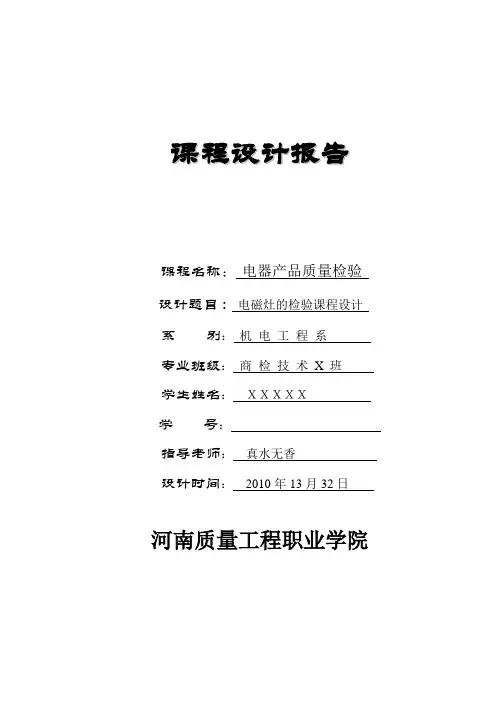
课程设计报告课程名称:电器产品质量检验设计题目:电磁灶的检验课程设计系别:机电工程系专业班级:商检技术X 班学生姓名:XXXXX学号:指导老师:真水无香设计时间:2010年13月32日河南质量工程职业学院河南质量工程职业学院机电工程系课程设计任务书专业班级学号学生姓名指导教师设计题目电磁灶的检验课程设计主要设计内容利用所学知识及参考资料对电炒锅进行结果原理分析以及性能的检验主要技术指标1)输入功率:不大于额定输入功率的1.05 倍(220V AC)2)电气强度:施加3750V-50Hz的交流正弦波电压,历时1min不击穿,无闪络现象3)泄漏电流:不大于0.25mA工作计划及安排2010/12/20~2010/12/20 确定内容2010/12/21~2010/12/24 查找资料2010/12/25~2010/12/27 设计正文2010/12/28~2010/12/31 最后审核主要参考资料及文献[1] 李德明.王庆志.电工电气产品质量检验[M].上海:同济大学出版社, 2007.[2] 杨其华.电器产品质量检验.[M].北京:中国计量出版社,1998.[3] 席宏卓.质量检验技术.[M].北京:中国计量出版社,2003.[4] 中华人民共和国轻工业标准.轻工业标准化编辑出版委员会:中国轻工业出版社,2006.目录1.设计目的 (4)2.结构原理 (4)2.1电磁灶的工作原理 (4)2.2电磁灶的分类 (4)3.设计依据 (5)4.检验项目 (6)5.检验过程 (6)5.1输入功率 (6)5.2发热实验 (6)5.3防水试验 (6)5.4工作温度下和湿热实验后的电气绝缘和泄漏电流 (6)5.5非正常工作 (7)5.6其它技术的指标的检验见标准的有关条文进行 (8)总结 (9)参考文献 (10)1.设计目的电磁灶是一种利用电磁感应加热方法烹调食物的家用电热炊具,它具有安全、卫生、高效、节能的特点,因此得到广大家庭的普遍应用。

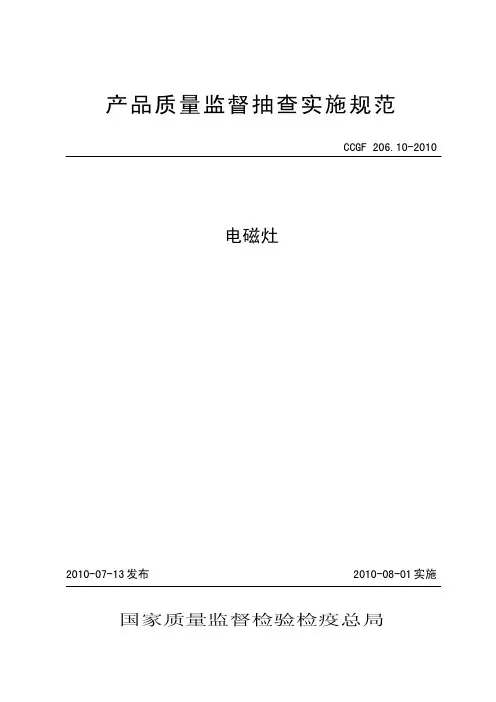
产品质量监督抽查实施规范CCGF 206.10-2010电磁灶2010-07-13发布 2010-08-01实施 国家质量监督检验检疫总局电磁灶产品质量监督抽查实施规范1 范围本规范适用于电磁灶产品质量国家监督抽查,针对特殊情况的专项国家监督抽查、省级质量技术监督部门组织的监督抽查可参照执行。
监督抽查产品范围包括电磁灶。
本规范内容包括产品分类、术语和定义、企业规模划分、检验依据、抽样、检验要求、判定原则、异议处理复检及附则。
注:针对特殊情况的专项国家监督抽查是指应急工作需要而进行的或者由于某种特殊原因(或情况)仅需要对部分项目进行抽样检验的专项监督抽查。
2 产品分类2.1 产品分类及代码表1 产品分类及代码产品分类 一级分类 二级分类 三级分类分类代码 2 206 206.10分类名称 日用消费品 家用电器 电磁灶2.2 产品种类电磁灶产品包括便携式电磁灶、驻立式电磁灶。
3 术语和定义本规范中未列出的术语和定义同相关引用标准。
4 企业规模划分根据电磁灶产品行业的实际情况,生产企业规模以电磁灶产品年销售额为标准划分为大、中、小型企业。
见下表:表2 企业规模划分企业规模 大型企业 中型企业 小型企业 销售额(万元) ≥30000 ≥3000且<30000 <30005 检验依据凡是注日期的文件,其随后所有的修改单(不包括勘误的内容)或修订版不适用于本规范。
凡是不注日期的引用文件,其最新版本适用于本规范。
1.GB 4706.1 《家用和类似用途电器的安全 第一部分: 通用要求》2.GB 4706.22 《家用和类似用途电器的安全 驻立式电灶,灶台,烤炉及类似用途器具的特殊要求》3.GB 4706.29 《家用和类似用途电器的安全 电磁灶的特殊要求》4. GB 21456-2008 《家用电磁灶能效限定值及能源效率等级》5. 经备案现行有效的企业标准及产品明示质量要求 6 抽样6.1 抽样型号或规格抽样时优先抽取单灶头便携式的产品。

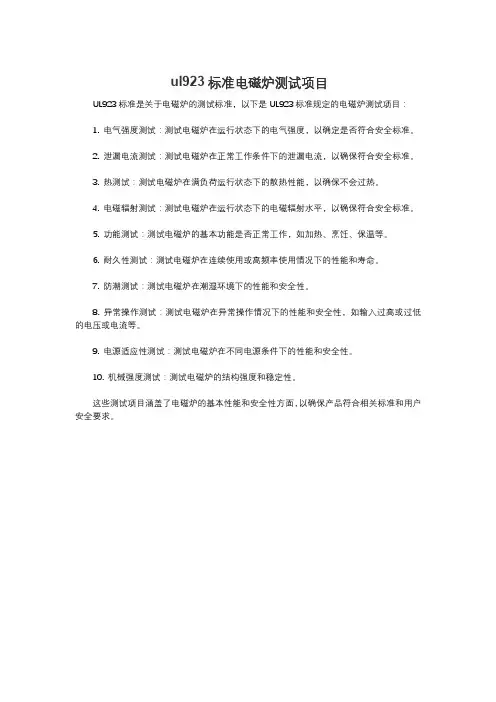
ul923标准电磁炉测试项目
UL923标准是关于电磁炉的测试标准,以下是UL923标准规定的电磁炉测试项目:
1. 电气强度测试:测试电磁炉在运行状态下的电气强度,以确定是否符合安全标准。
2. 泄漏电流测试:测试电磁炉在正常工作条件下的泄漏电流,以确保符合安全标准。
3. 热测试:测试电磁炉在满负荷运行状态下的散热性能,以确保不会过热。
4. 电磁辐射测试:测试电磁炉在运行状态下的电磁辐射水平,以确保符合安全标准。
5. 功能测试:测试电磁炉的基本功能是否正常工作,如加热、烹饪、保温等。
6. 耐久性测试:测试电磁炉在连续使用或高频率使用情况下的性能和寿命。
7. 防潮测试:测试电磁炉在潮湿环境下的性能和安全性。
8. 异常操作测试:测试电磁炉在异常操作情况下的性能和安全性,如输入过高或过低的电压或电流等。
9. 电源适应性测试:测试电磁炉在不同电源条件下的性能和安全性。
10. 机械强度测试:测试电磁炉的结构强度和稳定性。
这些测试项目涵盖了电磁炉的基本性能和安全性方面,以确保产品符合相关标准和用户安全要求。
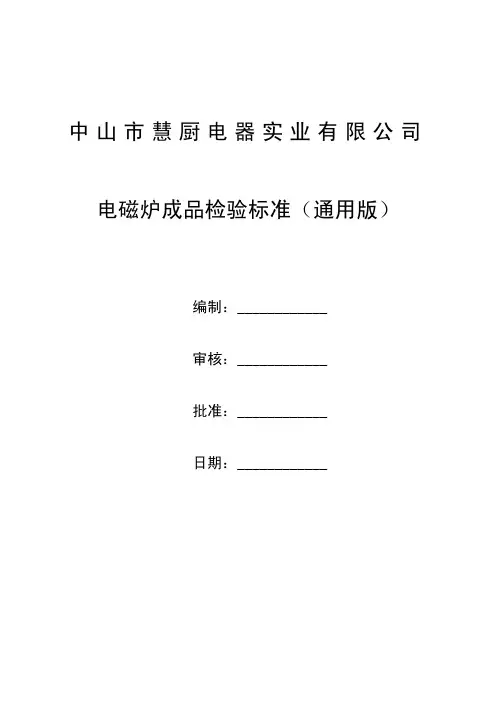
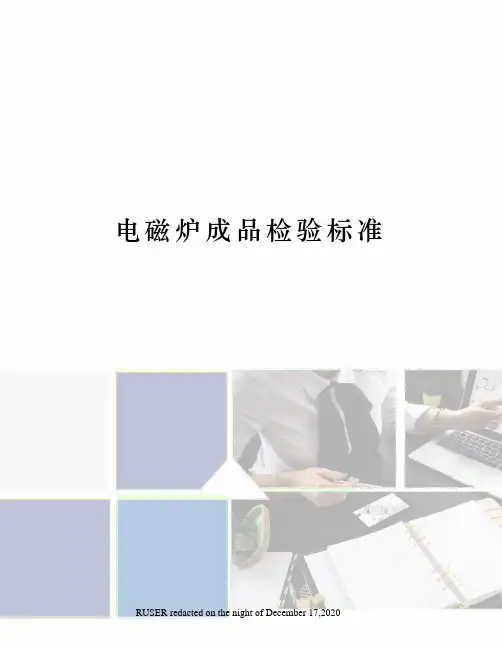
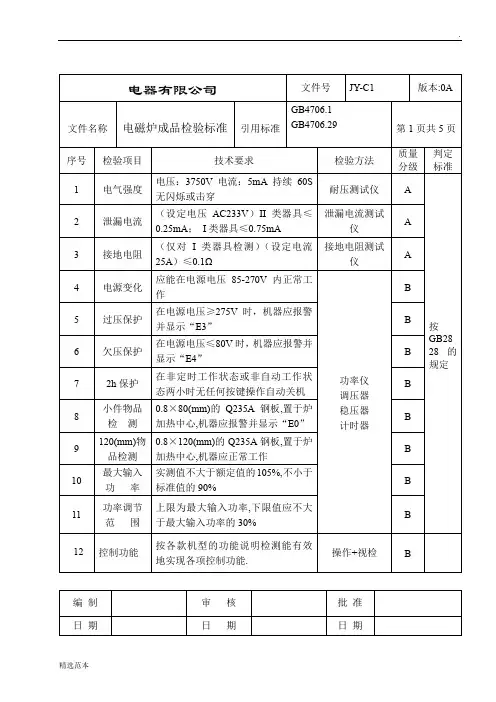
电磁炉外观检验标准一、范围本标准规定了电磁炉产品的外观质量,检验要求。
本标准适用于生产的电磁炉产品的外观验收。
二、引用标准GB191包装贮存图示标志GB2828逐批检查计数抽样程序及抽样表(适用于连续批的检查)GB6388运输包装收发货标志三、名词术语3.1主要表面电磁炉产品使用状态下,眼睛平视可看见的面以及左、右面3.2非主要表面电磁炉是指产品使用状态下,底面或后面。
3.3内部表面电磁炉是指拆卸后才能看到的表面。
四、检验方法4.1表面分类:4.1.1检查面-指产品能看见的表面,它包括正面、侧面和底面三个表面。
4.1.2正面-指在最经常能被看到的主面。
4.1.3侧面-指要在某种方向的视线才能看到的表面。
4.1.4底面-指很少被见到或要在拆装时才能见到的表面。
(如图所示):4.2检查条件:4.2.1环境光亮度应在600-1000LUX 的光线,且光源应高于检查者的头部。
4.2.2环境四周不能有反光面。
4.2.3人眼与被测的零件的距离应保证在40cm ,且与检测零件的角度为45°,(如图所示)5.3检查范围时间如下:检测面 正面 侧面 底面 时间10秒5秒5秒五、 电磁炉外观验收要求40CM45ABBBCBA :正面B :侧面C :底面或内面5.1面壳与底壳色泽均匀光洁,表面无变形、毛刺、破裂、批锋,无明显划痕、黑点等不良现象,不明显划痕长度不大于20mm,无明显手感,黑点不大于ф1.5mm。
5.2陶瓷面板a.与面壳结合紧密,无离口存在,结合处无胶溢出;b.瓷板表面光洁,无混色,无表面波纹及明显的印丝不良,机械损伤不超过1mm2,间距150mm,且不得超过2处;c.瓷板周边的锯齿形损伤深度不超过1mm;5.3控制面板表面丝印及字迹清晰,渐变色颜色过渡自然,表面无划伤,非按键部位无凹凸等不良;5.4标识铭牌、图案、文字清晰。
5.5配锅a.主要内表面不允许超过ф0.5mm的庇点,在ф200mm的范围内,不超过4处;b.主要内表面不允许超过20mm的划痕,不超过2处,不得有明显手感;c.外形应对称,锅体主体不圆度≤2mm;d.无毛刺、无刃口,翻边部分无法抛光的部位在加工前应打磨光亮;e.玻璃盖上的标志印刷清晰,附着牢固,表面清晰、透明、无五彩、气泡、轻微划伤长度不超过3mm,不超过2处;f.不锈钢镶边表面无明显凹凸和伤痕,表面亮度均匀,金属气孔应完好,无毛刺。
商用电磁炉商品品质抽检规范前言为维护自营商品品质、保护消费者的合法权益,将不定期对商品进行抽检,抽检商品委托国家认定的第三方质检机构进行检测判定。
一旦发现商品品质存在问题,将依据双方协议要求,要求供应商承担违约责任,情节严重的将根据相关服务条款作终止合作处理。
商城电磁炉商品品质抽检规范由制定,有权对本规范进行相关修订。
第一章适用范围本规范适用于自营商用电磁炉类商品;包括不作为家庭使用的商用电磁灶、及类似电磁感应加热源的灶炉类器具。
对于连接一条相线和中性线的单相器具,其额定电压不超过 250V,其他器具不超过480V。
第二章抽样方式2.1采用购买线上店铺的商品的方式。
2.2采用抽检线下仓库中的商品的方式。
如抽样无法满足检验要求,只检验其中一部分项目。
第三章检验依据3.1以下所示标准以其最新版本适用于本规范GB4706.1《家用和类似用途电器的安全第 1 部分:通用要求》;GB4706.52 《家用和类似用途电器的安全第 2 部分:商用电炉灶、烤箱、灶和灶单元的特殊要求》;3.2经备案现行有效的企业标准及产品明示质量指标和要求或其他相适应的产品标准;3.3相关的法律法规、部门规章和规定第四章检验方国家认定的具有 CNAS 与CMA 资质的第三方质检机构。
第五章检验要求5.1产品质量检验项目(见表 1)5.2产品质量检验要求说明5.2.1分类器具应具有适当的电击防护类别、防水等级。
应符合 GB4706.1、GB4706.52 标准中第 6 章中规定的要求。
其中特别注意:要求器具电击防护类别,应当是Ⅰ类电击防护类别;对有害进水的防护等级,在桌面上使用的防水等级应至少IPX3,其他的至少为 IPX4。
5.2.2标志和说明为正确引导用户使用产品,器具应有相应的标志和说明。
应符合 GB4706.1、GB4706.52 标准中第 7 章中规定的要求。
5.2.3对触及带电部件的防护器具的结构和外壳应使其对意外触及带电部件有足够的防护。
广东星立方厨电集团有限公司灶具成品检验标准发布日期:發目录前言错误!未定义书签。
1 范围错误!未定义书签。
2 规范性引用文件错误!未定义书签。
3 分类错误!未定义书签。
规格与型号错误!未定义书签。
灶具的类型错误!未定义书签。
灶具的型号编制方法错误!未定义书签。
4 技术要求错误!未定义书签。
5 基本要求错误!未定义书签。
6 其它部件要求错误!未定义书签。
7 各部件间隙要求错误!未定义书签。
8 内部检查错误!未定义书签。
9 附件要求错误!未定义书签。
10 初期寿命试验错误!未定义书签。
11 安规要求错误!未定义书签。
12 试验方法错误!未定义书签。
试验室条件错误!未定义书签。
试验用燃气错误!未定义书签。
灶具试验状态错误!未定义书签。
气密性试验错误!未定义书签。
热负荷试验错误!未定义书签。
燃烧工况试验错误!未定义书签。
安全装置试验错误!未定义书签。
电点火装置试验错误!未定义书签。
使用性能试验错误!未定义书签。
13 检验规则错误!未定义书签。
出厂检验错误!未定义书签。
型式检验错误!未定义书签。
单台检验判定原则错误!未定义书签。
14 标志、包装、运输、贮存错误!未定义书签。
标志错误!未定义书签。
包装错误!未定义书签。
运输错误!未定义书签。
贮存错误!未定义书签。
15 试验报告错误!未定义书签。
16 备注错误!未定义书签。
前言本标准是根据成品抽样要求编制,作为本集团所生产的灶具成品检测的依据。
本标准按GB/T 的规则编制起草。
本标准由本集团质量管理部归口和解释。
本标准修改记录:灶具成品检验标准 范围本标准适用于燃气灶具产品成品检验的控制。
本标准规定了家用燃气灶具的术语和定义、产品分类、要求、试验方法、检验规则和标志、包装、运输、贮存。
本标准适用于使用城市燃气的家用燃气灶具及使用城市燃气和电能的内销家用气电两用灶具,包括: 单个燃烧器额定热负荷≤ kW 的燃气灶;额定热负荷符合a )规定、电的总额定输入功率≤ kW 的气电两用灶具。
1外观要求对电磁炉外观检查采用视检方法,外观应光洁,铭牌、图案、文字应清晰,部件无缺陷,紧固件不松动,塑料件、电镀件表面应光滑,色泽应均匀,无斑点,不应有气泡、脱落和裂纹。
2高温储存在55±2C环境中储存后测试安规项目应满足国家标准,电磁炉外壳不得有变形、变色现象,陶瓷面板应粘接牢固,无脱胶、裂缝、破裂现象按键操作不得出现滞后或死键现象,应能正常连续工作。
试验方法:将电磁炉放置于高温试验箱,启动试验箱使箱温匀速上升,将箱内温度控制在55±2C,保持2小时,然后关断试验箱的电源开关使箱温逐渐下降到25°C左右,取出电磁炉在试验室的环境温度下启动电磁炉连续工作两小时应无异常,必须符合要求。
3湿热试验在40±2C,相对湿度45%s86%的蒸汽试验室中,不通电存放48h,恢复2h后测试安规项目应满足国家标准,电磁炉外壳不得有变形、变色现象,陶瓷面板应粘接牢固,无脱胶、裂缝、破裂现象按键操作不得出现滞后或死键现象,能正常连续工作2h无异常出现。
试验方法:将电磁炉置于40±2C,相对湿度45%s86%的蒸汽试验室中,不通电存放48h,恢复2h后连续工作2h应无异常出现,应符合要求。
4低温储存试验在"∙20C±2匕”的环境下电磁炉应能正常启动并工作,储存4小时后取出电磁炉应能正常工作。
试验方法:将电磁炉放入低温试验箱(电冰柜),启动试验箱,使箱温匀速下降到-20±2°C,在额定电压下通电密封储存4小时后取出之前通电启动工作5分钟,让电磁炉在试验室环境温度下放置1小时后测试安规项目应能满足要求,测试完毕启动电磁炉连续加热2小时,应无异常出现,应符合要求。
5倾跌试验电磁炉按规定的方法进行试验,试验完毕检查应无损伤,应能正常连续工作。
试验方法:将电磁炉置于水平木质台面上,以电磁炉较长一边为轴,将另一边提起45度(与水平台面夹角),然后放开,连续倾跌三次。
电磁炉重要零部件检验规定桥整、IGBT、高压电容属电磁炉的重要零部件,对此类重要零部件的检验规定如下:1、桥整1)桥整进货时必须进行全检;2)检验设备选用晶体管特性图示仪;3)检验桥整的正、反向耐压是否符合规格书要求;4)检验桥整的耐压特性曲线是否具有一致性,并且具有雪崩特性;5)检验封装耐压是否符合要求;6)进行耐温试验(抽检),将抽检样品放入烘箱加热,保温80℃至8小时,恢复常温后,再测试桥整的耐压曲线应无变化。
7)被检桥整不良率为3‰,属正常范围,如果不良率超过3‰,且桥整的性能曲线离散性较大,则停止检验,通知供货商分析不良原因或作退货处理。
2、IGBT1)IGBT进货时必须进行全检;2)检验设备选用JL294-3晶体管直流参数测试仪;3)检验IGBT耐压是否符合规格书要求;4)检验时特别注意IGTB G极必须接地;5)检验时必须采取必要的防静电措施;6)检验时注意对IGBT进行分类,例如,被检IGBT耐压为1200V,则检出的IGBT耐压大于1300V分为一类,用于2000W电磁炉,如果检出的IGBT耐压在1200V-1300V之间分为另一类,用于1800W以下电磁炉,如果检出的IGBT耐压小于1200V,则判断为不合格。
7)被检IGBT不良率为3‰,属正常范围,如果不良率超过3‰,且IGBT的耐压参数离散性较大,则停止检验,通知供货商分析不良原因或作退货处理。
2、高压电容1)高压电容进货时必须按标准进行抽检;2)检验设备选用LCR参数测试仪;3)检验电容容量、耐压、损耗角、外观尺寸、标识等是否符合规格书要求;4)进行耐温试验,将抽检样品放入烘箱加热,保温80℃至8小时,恢复常温后,再测试电容的各项性能应无变化。
5)根据抽检质量水平来判断不良率是否正常,若不正常则停止检验,通知供货商分析不良原因或作退货处理。
以上检验都必须做好测试记录。
电磁炉电路板简单维修方法一、电路板烧IGBT或保险丝的维修程序电流保险丝或IGBT烧坏,不能马上换上该零件,必须确认下列其它零件是在正常状态时才能进行更换,否则,IGBT和保险丝又会烧坏。
电磁炉电磁灶成品检验标准
1. 适用范围
本标准适用于本公司生产及OEM电磁炉产品验收检验、入库检验(二次检验)和出厂检验。
特殊型号产品的具体要求按照技术要求规定的参数检验。
对于该标准中规定的内容,在今后的执行过程中将有必要随着国家相关标准的变动以及发现新的问题而进行更改。
但任何内容和形式的更改,都必须经相关授权部门负责人员共同协商并确认可后方可进行,严禁任何一方单方面私自进行更改。
2. 引用标准
下列文件中的条款通过本标准的引用而成为本标准的条款。
凡是注日期的引用文件,其随后所有的修改单(不包括勘误的内容)或修订版均不适用于本标准,然而,鼓励根据本标准达成协议的各方研究是否可使用这些文件的最新版本。
凡是不注日期的引用文件,其最新版本适用于本标准。
GB 4706.1-2005 家用和类似用途电器的安全:通用要求
GB 4706.29-2008 家用和类似用途电器的安全:电磁灶的特殊要求
QB/T1236-2008 电磁灶
GB 21456-2008 家用电磁灶能效限定值及能源效率等级
3、术语说明
A类不合格——(特指致命缺陷英文CRITICAL,简写CR)指对产品的使用者构成直接的人身伤害、或者会产生潜在的安全隐患的缺陷。
(如漏电、利边及内含有毒物质)
B类不合格——(特指严重缺陷英文MAJOR,简写MAJ)指产品有使用功能缺陷、或者外观上有明显的不良缺陷。
(如按键不灵、装配不符及外观上严重划伤、破损等)
C类不合格——(特指轻微缺陷英文MINOR,简写MIN)指产品除去CR和MAJ以外的所有轻微不良缺陷。
仅只对最终产品的质量只构成一些外观上的影响。
(如凹、凸痕、色差以及轻微划伤、变
形等)
质量接收限—(英文ACCEPTABLE QUALITY LAVEL,简写AQL)指由相关顾客、分供方、组织共同协商而达成最终产品验收标准值。
允收——(英文ACCEPTABLE,简写A C)指产品经过相关程序检验并判定其质量为可接收的合格品。
拒收——(英文REJECT,简写R e)指产品经过相关程序检验并判定其质量为不可接收的不合格品。
4. 批量抽样方案和判定
成品入库(出厂)抽检及OEM产品入库二次抽验以送交检验批数量作为一个检验批,采用特殊检验
水平S-4正常检查一次抽样方案,检查水平、不合格质量水平和不合格判定数见表1。
对于以上检验中判定为不合格批,必须经过百分百的重新检查返工后再提交检验,对于再提交检查的批,采用一般检验水平II加严检查一次抽样方案,检查水平、不合格质量水平和不合格判定数见表2。
4.检验项目。